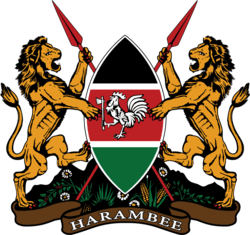Elections in Kenya
 |
| This article is part of a series on the politics and government of Kenya |
|
Constitution |
|
Legislature
|
|
|
Administrative divisions |
|
|
| Foreign relations |
|
Economic schemes |
|
Politics portal |
Elections in Kenya in recent years have been cause for violence and fragmentation, such as during the presidential elections of 2007. Though a multiparty democracy since 1992 and holding elections since 1962, the country has serious institutional problems which make it hard for elections to be completed smoothly.[1]
Structure
Kenya elects on national level a head of state - the president - and a legislature. The president is elected for a five-year term by the people. The Parliament or Bunge has two houses: the National Assembly and the Senate. The National Assembly has 349 members, 290 members elected for a five-year term in single-seat constituencies, 47 elected Women representatives(one per County, 12 members nominated to represent party strength in the lower chambers and an ex officio speaker. The Senate comprises 67 members: 47 elected senators from each of Kenya's 47 Counties, 20 nominated senators (16 to represent women, 2 to represent youth and 2 to represent people with disabilities)
History
After negotiation with the British since 1957, the British allowed "one person, one vote" elections in 1963.[1] The first elections went smoothly, electing Jomo Kenyatta as the first president of Kenya in 1964.[1] However, under his leadership, competitive elections slowly disappeared as various political parties either joined or were suppressed by the Kenya African National Union (KANU).[1] This consolidated single-party system would last even after Kenyatta died in 1978, eventually reaffirmed in an amendment to the constitution in 1982 which made Kenya a one party system.[1]
After major political demonstrations in 1990, KANU bowed to public pressure and began reviewing the electoral system.[1] In 1992 the amendment that had maintained a single party system was revoked, returning Kenya to multi-party elections.[1] The constitutional shift did not immediately manifest itself in well run multiparty elections.[1] However, by 2002 the international community thought the electoral system generally free, as KANU peacably transferred power to the National Rainbow Coalition (NARC).[1]
Multi-party elections since 1992
- Kenyan general election, 1992
- Kenyan general election, 1997
- Kenyan general election, 2002
- Kenyan general election, 2007
- Kenyan general election, 2013
See also
- Electoral calendar
- Electoral system
- Machel Waikenda
References
External links
- African Elections Database
- Adam Carr's Election Archive
- 2008 IFES analysis of Kenya's electoral history titled The Electoral Process in Kenya: A Review of Past Experience and Recommendations for Reform
| ||||||||||||||||||||||
| |||||||||||||||||||||||||||||||||||||||||||||